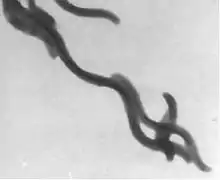Rhodospirillaceae
The Rhodospirillaceae are a family of Pseudomonadota. The majority are purple nonsulfur bacteria, producing energy through photosynthesis; originally all purple nonsulfur bacteria were included here.[4][5]
| Rhodospirillaceae | |
|---|---|
| Scientific classification | |
| Domain: | Bacteria |
| Phylum: | Pseudomonadota |
| Class: | Alphaproteobacteria |
| Order: | Rhodospirillales |
| Family: | Rhodospirillaceae |
| Genera[1][2][3] | |
| |

Magnetospirillum magnetotacticum with magnetosome chains faintly visible
They are often found in anaerobic aquatic environments, such as mud and stagnant water, although they are able to survive in air.[4]
This family also includes Magnetospirillum, which contains tiny chains of magnetite.[4] These let it sense the Earth's magnetic field, which runs downwards as well as north or south, to return to the bottom of a pond (magnetotaxis). Similar magnetite chains found in Martian meteorites have been suggested as evidence of life on Mars.[6]
References
- Euzéby JP, Parte AC. "Rhodospirillaceae". List of Prokaryotic names with Standing in Nomenclature (LPSN). Retrieved August 18, 2021.
{{cite web}}: CS1 maint: uses authors parameter (link) - UniProt
- eol
- George M. Garrity, Don J. Brenner, Noel R. Krieg, James T. Staley (Hrsg.): Bergey's manual of systematic bacteriology. Vol. 2: The Proteobacteria Part C: The Alpha-, Beta-, Delta-, and Epsilonproteabacteria. 2. Auflage. Springer, New York 2005, ISBN 978-0-387-24145-6
- Martin Dworkin, Stanley Falkow, Eugene Rosenberg, Karl-Heinz Schleifer, Erko Stackebrandt: The Prokaryotes, A Handbook of the Biology of Bacteria. Volume 5: Proteobacteria: Alpha and Beta Subclasses ISBN 978-0-387-25495-1
- Peter R. Buseck, Rafal E. Dunin-Borkowski, Bertrand Devouard, Richard B. Frankel, Martha R. McCartney, Paul A. Midgley, Mihály Pósfai, and Matthew Weyland: Magnetite morphology and life on Mars In: Proceedings of the National Academy of Sciences 2001 November 20; 98(24): 13490–13495. Online
This article is issued from Wikipedia. The text is licensed under Creative Commons - Attribution - Sharealike. Additional terms may apply for the media files.